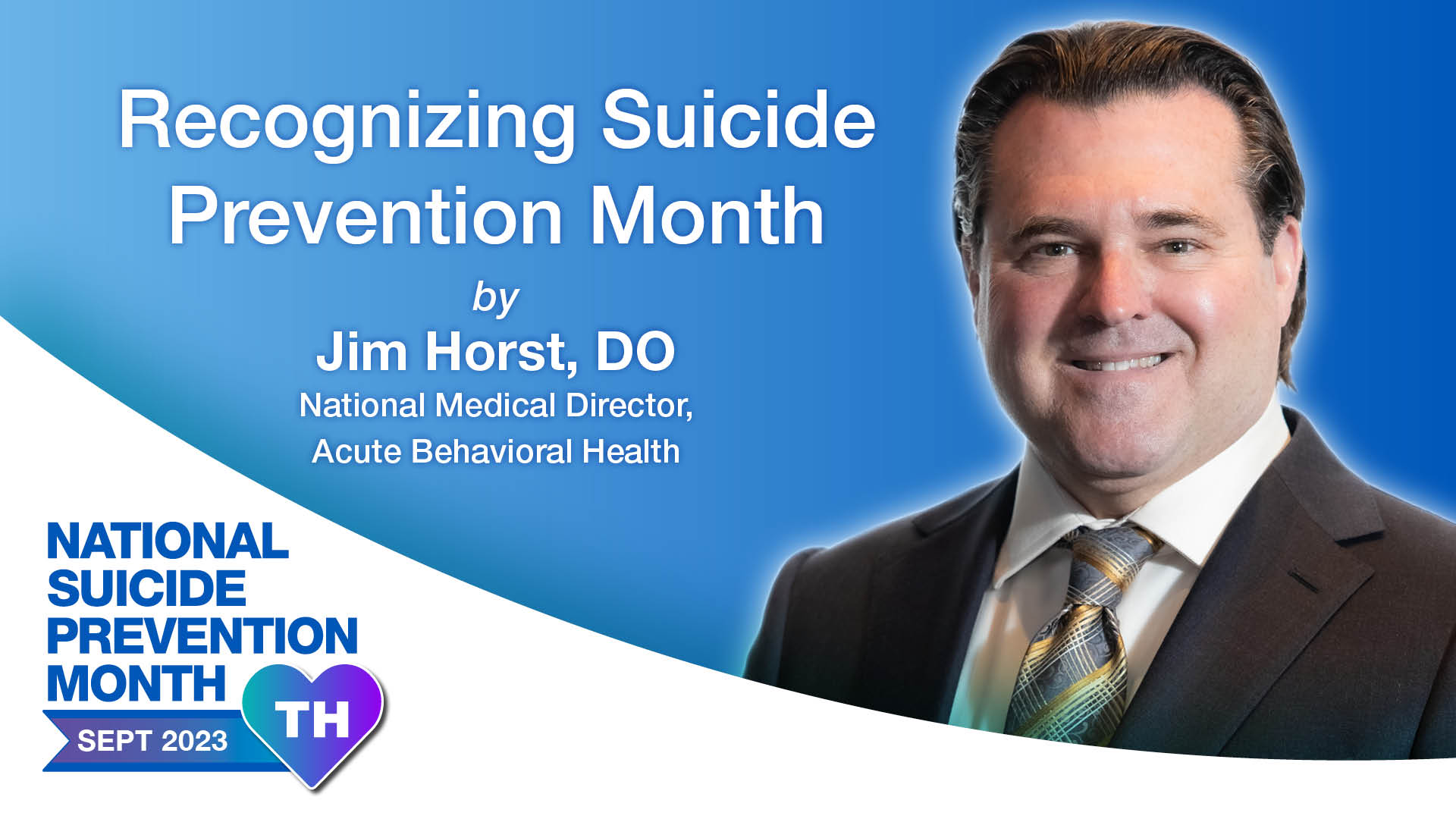By Dr. Jim Horst, National Medical Director, Acute Behavioral Health
Why It’s Important to Recognize Suicide Prevention Month
Every September, we recognize National Suicide Prevention Month. Suicide remains one of the leading causes of death in the United States (1). Suicide is a serious public health concern that impacts all people, regardless of age, race, and background and can affect those in every industry, and it is prevalent in healthcare. This month, it is increasingly important to highlight the need to remove stigma related to suicide and to raise awareness for the resources available to those suffering from mental health crisis.
Statistics and Data about Suicide in the U.S.
Culturally there have been shifts in who is impacted the most by suicide. It’s important to recognize key statistics about suicide in order to better understand what demographics are largely impacted and provide resources to support those suffering.
Individual Impact
- Suicide affects doctors at a rate that is 1.4 to 2.3 times higher than the general population (6).
- Physicians suffer from higher rates of burnout, depressive symptoms and suicide risk than the general population (7).
- 28% of residents experience a major depressive episode during training versus about 7% to 8% of similarly aged individuals in the U.S. general population (7).
- 79% of all people who die by suicide are male.
- Although more women than men attempt suicide, men are 4x more likely to die by suicide.
- Suicide is the second leading cause of death among people aged 10-14, the third leading cause of death among those aged 15-24 and the twelfth leading cause of death overall in the U.S.
- 46% of people who die by suicide had a diagnosed mental health condition — but research suggests that 90% may have experienced symptoms of a mental health condition.
Data is from the CDC, NIMH
Community Impact
- Annual prevalence of serious thoughts of suicide, high-risk populations:
- S. Adults: 4.8%
- Native Hawaiian/other Pacific Islander: 7.4%
- Mixed/Multiracial: 8.2%
- American Indian/Alaska Native: 8.5%
- Young adults aged 18-25: 13%
- High school students: 22%
- LGBTQ youth: 41%
- The highest rates of suicide in the U.S. are among American Indian/Alaskan Natives, followed by non-Hispanic whites
- Physicians have one of the highest suicide rates of any profession (5).
- Lesbian, gay and bisexual youth are four times more likely to attempt suicide than straight youth.
- Transgender adults are nearly nine times more likely to attempt suicide at some point in their life compared to the general population.
- Suicide is the leading cause of death for people held in local jails.
Data is from the CDC, NIMH
Resources to Support Suicide Prevention
If you or a loved one is suffering, there are several resources available. The National Suicide & Crisis Lifeline is available 24/7, and completely confidential. You can call or text the 988 hotline and learn more here (4). It’s extremely important to raise awareness about resources like the 988 hotline to reassure those suffering from a mental crisis that there is help. Suicide can be prevented.
Another resource is the National Alliance on Mental Illness. You can text NAMI at 741-741 to be connected to a free, trained crisis counselor on the Crisis Text Line (2).
Breaking stigmas related to suicide is key to broaden conversations about mental health and help prevent suicides and help save lives.
Learn more about our dedication to clinician well-being and how our teams encourage our clinical and non-clinical workers to prioritize their mental health.
References
- Suicide Data and Statistics | Suicide | CDC
- Suicide Prevention Month | NAMI: National Alliance on Mental Illness
- Social Media Resources | Suicide | CDC
- 988 Lifeline Chat and Text : Lifeline
- National Physician Suicide Awareness Day | NPSA Day
- Caring for Those Who Care for Us: Physician Suicide Awareness and Prevention | NAMI: National Alliance on Mental Illness
- Facts About Mental Health and Suicide Among Physicians: 1578319045-physician-mental-health-suicide-one-pager.pdf (datocms-assets.com)
